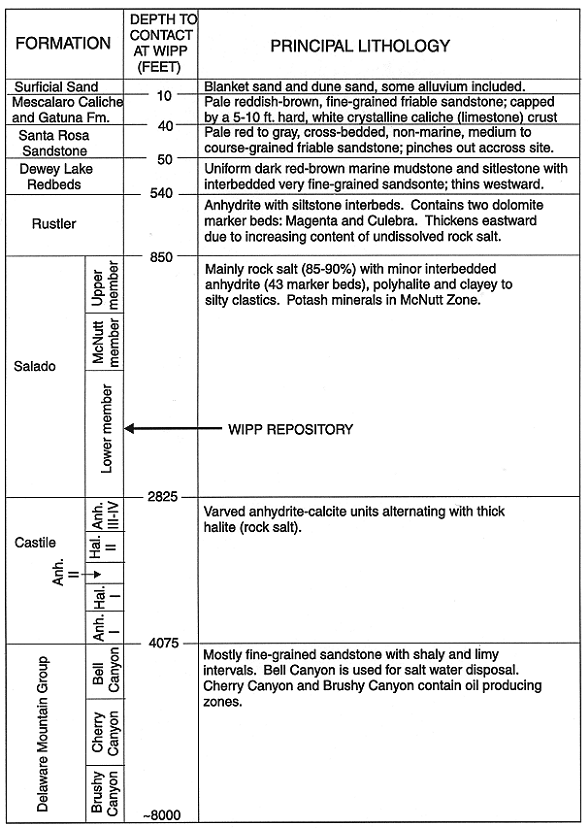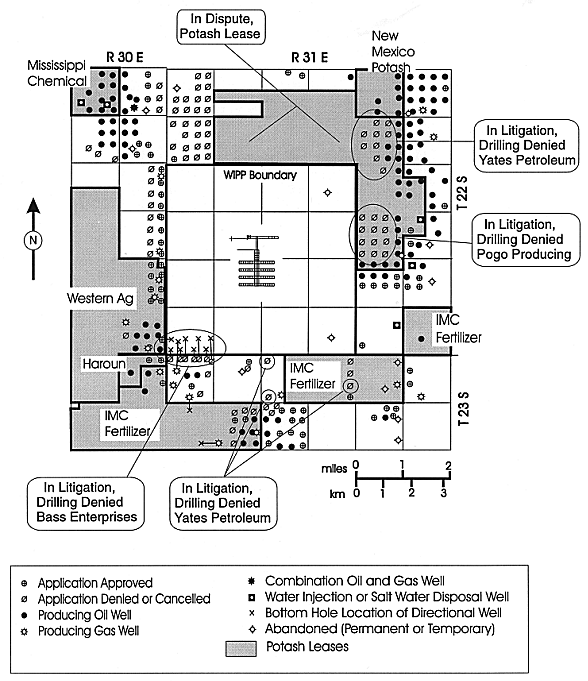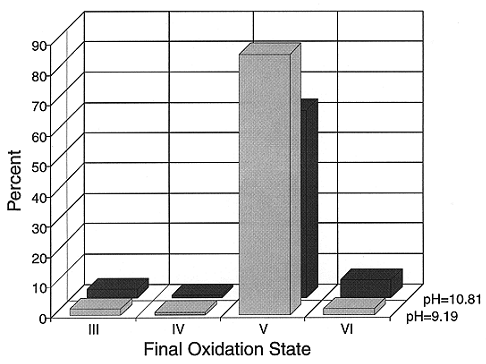
Fig. 1. Stratigraphic cross section at the WIPP Site.
Lokesh Chaturvedi, William W.-L. Lee, Matthew K. Silva,
Thomas M. Clemo and Robert H. Neill
Environmental Evaluation Group
7007 Wyoming Boulevard NE, Suite F-2
Albuquerque, NM 87109
ABSTRACT
An evaluation of the U. S. Department of Energy's (DOE) assessment of the long-term performance of the Waste Isolation Pilot Plant (WIPP) shows that several issues need to be resolved. The DOE Compliance Certification Application for WIPP disqualifies certain features, events, and processes on the basis of regulatory exemption without sufficient justification. Probabilities of some events are underestimated. Certain critical input parameters in calculations are chosen without sufficient justification or based on apparently erroneous assumptions. It is recommended that DOE address and resolve these scientific issues to justify the conclusions regarding the long-term integrity of WIPP.
INTRODUCTION
The Waste Isolation Pilot Plant (WIPP) in southeastern New Mexico is a planned geologic repository for defense transuranic (TRU) waste. Located 655 meters below the ground surface in bedded salt of Permian age, the repository has been planned to permanently isolate about 850,000 "drum-equivalents" of contact-handled transuranic waste (CH-TRU) containing 6.4 million curies of radioactivity, and 7500 canisters of remote-handled transuranic (RH-TRU) waste containing 1.0 million curies. Transuranic waste consists of long-lived alpha emitting actinides, such as Plutonium-239, which has a half-life of 24,000 years. The Environmental Protection Agency (EPA) requires an assessment of the ability of the geologic repository to isolate the waste for 10,000 years (1).
The Environmental Evaluation Group (EEG) conducts an independent technical evaluation of the impact of the WIPP Project on the public health and environment of New Mexico. Previous EEG publications have discussed the documentation of compliance with the EPA standard for the long-term integrity of a TRU waste geologic repository (2) and the geo-hydrological issues impacting the long-term integrity (3).
In late October 1996, DOE submitted the Compliance Certification Application (4) to EPA. EEG is also reviewing the application. This paper identifies four preliminary concerns.
GEOLOGIC ISOLATION FRAMEWORK FOR WIPP
The 1992 WIPP Land Withdrawal Act reserved a 4 mile by 4 mile (6.4 km x 6.4 km) square of federal land, for the WIPP project (5). At the surface, the WIPP site is covered with blanket sand and stabilized sand dunes with poorly developed drainage pattern and desert bushes. Figure 1 shows a geologic cross-section at the center of the WIPP site. The repository is located at a depth of 2150 feet (655 meters) in the lower part of the approximately 2000 ft (610 meter) thick Salado Formation, consisting of bedded salt (halite) and interbeds of anhydrite and clay. The upper part of the Salado Formation contains a 400 ft (122 meter) thick zone rich in potash minerals known as the McNutt Potash Member. The bottom of this zone is approximately 400 ft (122 meters) above the WIPP repository. A 310 ft (95 meter) thick Rustler Formation overlies the Salado and it contains two 25 ft (7.6 meter) thick fractured dolomite water-bearing zones, the Magenta and the Culebra. The more permeable Culebra is considered to be a potential pathway for migration of radionuclides to the biosphere in case of a breach of the repository. The Culebra aquifer is about 1425 ft (435 meters) above the repository.

Fig. 1. Stratigraphic cross section at the WIPP Site.
The Castile Formation underlies the Salado and its upper unit consists of varved alternating layers of anhydrite and calcite. At least 16 boreholes within 10 miles (16 km) of the WIPP site have encountered pressurized brine in this unit, about 800 ft (244 meters) below the repository level.
The WIPP site is situated in a region rich in potash and oil and gas. Producing oil and gas wells surround the site (Fig. 2). The nearest production of potash is currently about 7000 ft (2134 meters) from the southwestern corner of the site. Drilling for oil and gas through the potash reserves is restricted until potash mining is completed (Fig. 2).

Fig. 2. Producing oil and gas wells, drilling applications denied due to potash resources, and the potash leases surrounding the WIPP Site.
The 55 gallon (208 liter) drums and standard waste boxes will be stacked in 56 rooms (300 ft x 33 ft x 13 ft, i.e. 91 m x 10 m x 4 m) and access drifts of the repository. The RH-TRU canisters will be emplaced in 3 ft (0.91 meter) diameter horizontal holes in the walls of the rooms and drifts, at 8 ft (2.44 meter) centers. Carbon dioxide is expected to be produced through microbial degradation of organic materials in the TRU waste. The DOE is planning to place (MgO) as backfill to consume the CO2 and reduce the solubility of the waste.
The drums and waste boxes are expected to corrode and get crushed a few years after emplacement. Thus, the WIPP repository design primarily relies on the Salado Formation salt to contain the waste for 10,000 years. There are a number of scenarios and potential pathways for radionuclides to reach the accessible environment. These include "undisturbed" (i.e. no human intrusion) and "disturbed" (i.e. caused by human intrusion) scenarios. In the Compliance Certification Application (4), the DOE analyzes a number of scenarios and concludes that WIPP will remain in compliance with the allowable probabilities and amounts of releases for 10,000 years.
COMPLIANCE ISSUES TO BE RESOLVED
A preliminary review of the WIPP Compliance Certification Application (CCA) indicates that a number of issues remain to be resolved before WIPP can be certified to have met the EPA Standards. A few important issues are described below.
Disqualification of Features, Events, and Processes
The CCA (4) does not provide adequate justification for disqualifying legitimate features, events, and processes (FEPs) from consideration in the performance assessment calculations. The DOE maintains that 1) non-relevance, 2) low probability, 3) low consequence, or 4) regulatory exemption served as a basis for such elimination. While the first three DOE screening criteria provide a logical basis for eliminating certain FEPs, DOE's exclusion of activities that could result in consequences greater than those of drilling makes no sense and is an inappropriate interpretation of the intent of the EPA standards.
The fourth screening criterion (regulatory exemption) was introduced by DOE in the WIPP performance assessment in 1992 (6, p. 4-4) to eliminate consideration of any inadvertent human activity that could result in consequences greater than those of exploratory drilling. It has been used in the CCA to justify elimination of scenarios involving the effects of oil and gas production, underground injection of oil-field brines for disposal, water-flooding for secondary recovery of oil, underground storage of hydrocarbons, and many others (4, Table 6-5, pp. 6-53 to 6-56). The WIPP site is in a mineral rich area with a history of mining for potash, production of oil and gas, and solution mining of halite for production of brine to be used in drilling through the salt section. Many of the activities eliminated from the WIPP performance assessment have a long and well-documented history of occurrence in the Delaware Basin. Hence, it is difficult to rule them out citing a DOE interpretation of the EPA criteria or guidance. The compliance assessment is incomplete without consideration of all plausible scenarios.
Assumptions Regarding Castile Brine Reservoirs
A number of nearby oil and gas exploration wells and at least two WIPP exploration wells (ERDA-6 and WIPP-12) encountered pressurized brine in the upper part of the Castile Formation. The artesian pressure in these brine reservoirs was sufficient to propel water to the surface. The WIPP performance assessment therefore includes scenarios involving future inadvertent encounter of pressurized brine by a borehole drilled through the WIPP repository.
The CCA calculations specify that given a drilling intrusion into the waste in the repository, there is a probability of 8% that the intrusion would also encounter a brine reservoir in the Castile below the repository. That probability is essentially based on the ratio of 27 reported brine interceptions out of 354 wells drilled in the area of investigation surrounding WIPP. This analysis assumes that if an operator did not report encountering brine in the Castile to the U.S. Bureau of Land Management, or the N.M. State Oil Conservation Division, then the well did not in fact encounter brine. The assumption may not be justified because there is no requirement for drillers or operators to report such encounters. Pressurized brine encountered during drilling for a deeper target is just a nuisance to the driller. Unless it creates a significant hazard or delay, it is unlikely to be reported.
In addition, the analysis does not take into account that the brine reservoir in the Castile Formation intercepted by borehole WIPP-12, located approximately 1.25 miles (2 km) north of the repository, had an estimated volume of 2.7 x 106 m3 (17 million barrels, Ref. 7) of brine. Figure 3 shows a circle that would be needed as a foot-print of the WIPP-12 brine reservoir, assuming a reservoir thickness of 24 m, fitted between boreholes that did not encounter brine, and this circle covers the entire WIPP repository. Furthermore, a Time-Domain Electromagnetic Survey (Ref. 8) performed over the WIPP repository indicated presence of brine at the Upper Castile horizon. The assumed 8% probability of encountering brine therefore appears to be unreasonably low.

Fig. 3. Potential extent of WIPP-12 brine reservoir using WIPP-12 pressure recovery data, rock compressibility of 1x10-10Pa-1, and reservoir thickness of 24 meters.
The DOE estimate of the volume of brine in a reservoir underlying the repository has been reduced from 2.7 x 106 m3 (7) to a range of 32,000 m3 to 160,000 m3. The DOE justification is based on an argument that a reservoir of larger size would be depleted by future drilling outside the protected area of the repository. The analysis presented by DOE in support of this argument (4, p. 6-164) is not convincing.
Radionuclide Retardation Coefficients in the Culebra
The Culebra aquifer of the Rustler Formation is a possible groundwater pathway for release of radionuclides to the accessible environment. Chemical retardation of radionuclides is expected to occur during transport of contaminated water through the fractured dolomite of the Culebra aquifer. Our concern is with the values of retardation coefficients for various radionuclides used in the WIPP Compliance Certification Application. Lee and Chaturvedi (9) criticized the retardation coefficients used in previous performance assessments for the WIPP. In the CCA, the Department of Energy has used new data for estimating retardation coefficients that too appears to lack justification.
For many years there has been a controversy over whether values obtained using crushed rock samples in the laboratory can be scaled to represent field conditions. In October 1996 (10), the DOE presented geologic studies of the physical structure of the Culebra member of the Rustler Formation. Sorption can occur in pores of various scales. The surface area to volume ratio in crushed rocks sorption tests are similar to in-situ Culebra dolomite. DOE further showed that for long flow paths and long flow times, radionuclides would have sufficient time to diffuse into these pore spaces and sorb. Noting a reasonable theoretical basis for using batch Kd measurements for performance assessment in the CCA, we examined the DOE data and obtained different values as shown in Table I.
Table I Kds in CCA and EEG's Suggestion

Empirical sorption tests were done for all permutations of four types of brine; CO2 levels of 0.033%, 0.24%, 1.4%, or 4.1%; and no, low, intermediate or high levels of organics. Because DOE plans to add 7.8 x 107 kg of MgO as backfill, the fugacity of CO2 in the repository is expected to be 10-7. Thus, we discarded the results for CO2 levels of 0.24%, 1.4%, and 4.1%. We also discarded results that did not meet DOE's own quality control criteria and results from a set of mechanistic sorption experiments because the dolomite was not from the Culebra. The DOE had committed to use only WIPP-specific data in the CCA. The average of the batch results formed the upper end of a uniform distribution.
Results from flow-through experiments using rock cores formed the lower end of the uniform distribution. In some cases, there was no radionuclide breakthrough at 300 days, so a minimum estimated Kd, assuming breakthrough at 300 days was used.
The influence of organics on batch test results is shown in Table II. Even low concentrations of organics dramatically reduced Kd values. The WIPP is expected to have 1.6 x 104 kg of organics. We applied the reduction from no organics to low organics concentration to both the top and bottom range of values, resulting in the suggested values in Table I.
Table II Kds (ml/g) for various levels of organics in solution

The differences between Kd values used in the CCA and our suggested values stem primarily from the selection of relevant data. The DOE did not include the influence of organics on Kd values. Our suggested values may provide a more accurate estimate of potential sorption in the Culebra.
Dissolved Actinide Source Term
The assumed concentrations of the dissolved actinides used in the performance assessment of the CCA appear questionable. In case of inadvertent drilling into the WIPP, dissolved actinides might reach land surface or the boundary of withdrawn land. In the CCA, the dissolved actinide source term is estimated as the product of brine flow rate and actinide solubility. Because plutonium is 87% of the initial radioactivity accounted for in the performance assessment, it is instructive to look at the plutonium solubility only. In previous performance assessments (6), over 90% of the calculated releases consist of plutonium. Pu is assumed to exist only as Pu(III) and Pu(IV) in the repository. By what is known as the oxidation-state analogy, the solubility of Pu(III) can be calculated using thermodynamic data from Nd(III), and Pu(IV) from the thermodynamic data for Th(IV). Calculations of solubility in the CCA do not consider any redox reactions.
Transuranic waste arriving at the WIPP will have been exposed to air for several decades, and the plutonium is likely to be Pu(VI), at least initially. Solubility experiments show that Pu will be in the (VI) state at steady state, irrespective of initial condition. (11, 12).
Experiments have been performed to investigate the stability of Pu(VI) in repository condition. Because of the planned addition of 7.8 x 107 kg of MgO as backfill, the repository is assumed to be at pH of 10, and reducing. Reed et al. (13) reported, that for brine at pH of 8 to 10, and reducing conditions, Pu(VI) is stable with an apparent solubility of 10-4 M. Rao (14) reported that in alkaline conditions, it was not possible to reduce Pu(IV) below Pu(V), despite the addition of iron powder. Figure 4 shows the final oxidation state distribution in Rao's experiments. Clark and Tait (15) also concluded that Pu(VI) is stable in WIPP brines. Table III shows the solubility of plutonium in two types of WIPP brines, as calculated using the oxidation-state analogy, and the experimental results of Reed et al. (13).

Fig. 4. final oxidatio state of Pu by DBM extraction. Ref 14
Table III Solubiity of plutonium as determined by calculations and experiments

From Table III it is seen that the calculated solubilities used in the CCA are significantly different than experimental results. It is clear that additional justification is needed to explain the compatibility of the oxidation states used for Pu in the WIPP CCA and experimental findings of Reed et al., Rao, and Clark and Tait.
CONCLUSIONS
A great deal of scientific work over a 20 year period has formed the basis for the evaluation of long-term integrity of the WIPP project. Based on our preliminary review of the CCA, EEG has identified the issues that need to be resolved.
REFERENCES